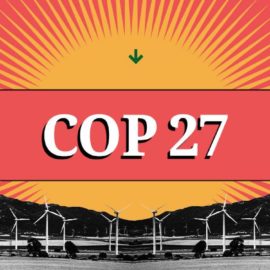
Bamboo shoots are nutritious but they can also build houses. This is one of the ideas coming out of COP27.
Homes built out of bamboo shoots. Zero-emission hydrogen fuels for cars and jets. Small nuclear reactors to power Africa. Restoring ocean mangroves to store carbon. Dozens of world leaders are gathered in Sharm el-Sheikh, Egypt, this week for the U.N. climate summit, known as COP27. They’re debating how to minimize the dangers of climate change and looking toward experimental technologies for help, as worries reach new highs. “We are on a highway to climate hell with our foot still on the accelerator,” U.N. Secretary General António Guterres said on Monday. “Our planet is fast approaching tipping points that will make climate chaos irreversible.” Political solutions look murky. The United States unveiled a contentious plan to raise billions to help developing nations wean off fossil fuels. Emerging countries want rich nations to compensate them for having to bear the brunt of the climate crisis — a difficult bid. Amid that, several scientific solutions are being touted as a way to help world leaders reach their goals of net-zero emissions. And as enthusiasm abounds for climate related technology, experts caution labeling any solution a silver bullet until proven otherwise. “A lot of it is hype,” said Vijay Modi, a climate expert and mechanical engineering professor at Columbia University. “But then there is stuff that is not hype but needs research to evaluate.” To learn more, The Washington Post talked with industry experts, entrepreneurs and academics about various climate technology solutions. Here are a few being discussed.
washingtonpost.com
Green Hydrogen
Hydrogen is one of the most abundant elements in the world, and creating it cleanly is increasingly seen as a core way toward achieving net-zero emissions by 2050, according to climate experts. Green hydrogen is a zero-emissions hydrogen fuel capable of powering planes, cars and homes. It’s produced using wind and solar power, along with a high-tech electrolysis process. By 2050, cleanly made hydrogen could remove seven gigatons of CO2 emissions annually if scaled successfully, roughly 20 percent of human-caused emissions, according to McKinsey. Andy Marsh, chief executive of New York-based Plug Power, said the focus on green hydrogen has bolstered his business, which makes green hydrogen fuel cells and power stations for customers such as Amazon, Walmart and Home Depot. His fuel cells and power stations help these companies power their distribution centers and delivery trucks. But green hydrogen is costly to make, and scaling it to meet ambitious climate goals will require political muscle. Marsh said leaders at the U.N. conference should do what President Biden’s Inflation Reduction Act did, and create tax credits to reimburse companies for every kilowatt-hour of energy they produce using green hydrogen. “It’s a carrot approach,” he said. “It’s not ‘We’re going to penalize you.’ It’s going to be: ‘We’re going to reward you if you generate green hydrogen.’ ”
Nuclear Power
For years, the idea of large nuclear power plants powering the world has drawn concern. Many worry about the dangers these reactors present to communities they’re near, as well as the radioactive waste they generate and high construction costs. The 2011 Fukushima nuclear disaster in Japan turned many countries away from it. But at this year’s climate conference, the technology is getting another look. Rafael Mariano Grossi, the director general of the International Atomic Energy Agency, said on Monday that the energy solution is crucial. “Nuclear energy as a clean energy source has a very important role to play to help us get to net zero faster,” he said in a statement. Nuclear trade associations are at the conference, saying nuclear power is already the world’s second-largest source of low-carbon power, providing roughly 10 percent of the world’s electricity from roughly 440 reactors. Others, such as House Republicans, say it’s also a matter of national security. “Twenty years ago, Belgium decided that nuclear was bad and they shut it down,” Rep. John Curtis(R-Utah) told The Washington Post. “Today, that energy has been replaced by dirty Russian natural gas.” Despite that, experts worry about the risks nuclear waste poses to society. The U.S. Energy Information Administration says waste material “can remain radioactive and dangerous to human health for thousands of years.”
Small modular reactors
Small modular reactors are mini versions of more traditional nuclear power stations that generate roughly one-third the energy. The nuclear industry has been trying to build these machines for years, promising they’ll be smaller, nimbler and safer than their conventional counterparts. These small-scale, zero-emission nuclear plants produced in factories could be used to power small communities in similar ways to natural gas plants, but absent the pollution, they say. Their size allows them to power more remote places than larger reactors. In the lead up to the U.N. conference, the United States and Japan announced they’d partner to help deploy small modular reactors in Ghana. Still, experts from Stanford and the University of British Columbia found that these reactors will generate more radioactive waste than conventional nuclear power plants.
Bamboo
More than 1640 different bamboo species populate the world, U.N. data shows, and it naturally grows in places such as Africa, Asia and Latin America. The plant is better at capturing and storing carbon from the atmosphere compared with timber, according to research. Since it’s the fastest growing woody plant in the world, scientists believe planting more can quickly remove carbon from the air, while replenishing it with oxygen. In China, where bamboo is abundant, the forests are projected to store 1 billion tons of carbon from the environment, an increase from 727 million tons in 2010, U.N. data said. Replacing traditional housing materials such as carbon and steel with bamboo helps reduce carbon emissions caused by the global housing sector, which represents a third of global greenhouse gas emissions.
Blue carbon
Blue carbon refers to carbon stored in coastal and marine environments. Oceans and places such as mangroves and sea grass are up to four times better at capturing and storing carbon than forests, scientists said. Climate advocates at the U.N. conference are urging countries to restore their nations’ oceans and marine ecosystems, which have been plagued by pollution caused from industries such as shrimp farming and palm oil. Emily Pidgeon, vice president of ocean science and innovation at Conservation International, an environmental nonprofit, said upwards of 3 percent of global greenhouse gas emissions could be removed from the environment if countries commit to restoration projects and blue carbon strategies. While that’s not a large number, Pidgeon said, these are things countries could do now. “These are actions we could be taking today,” she said. “Where many technologies, which are very important, are still five decades [away] to come online.”
These are ideas that we should think about – other than bamboo homes. Some of them we have companies and research going on now.



